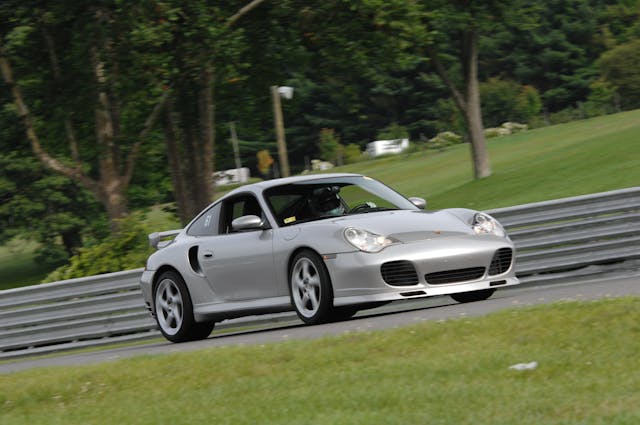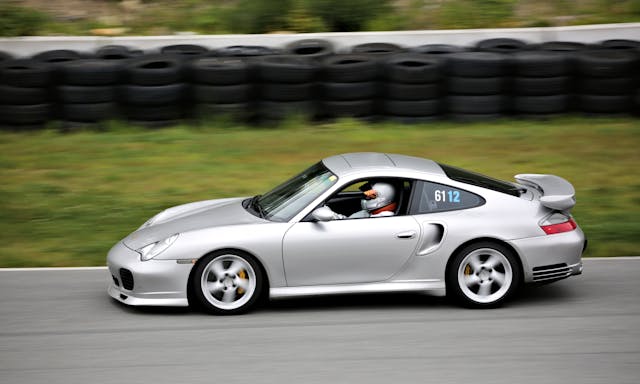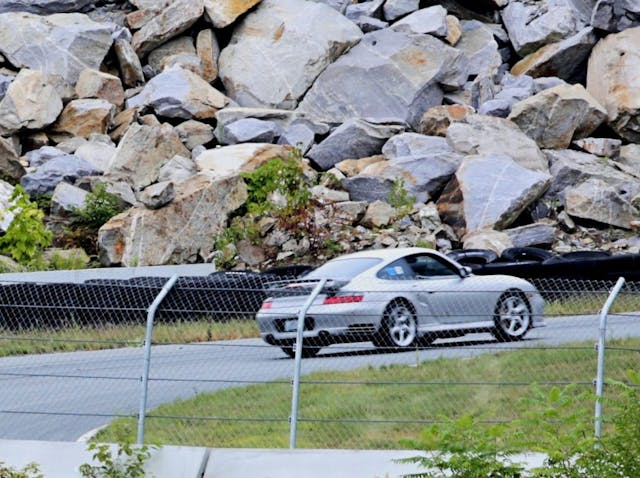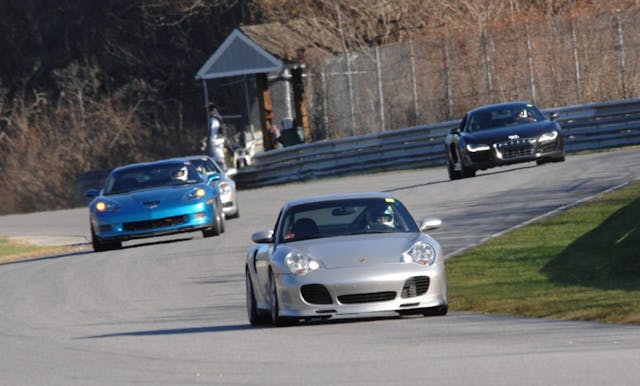Media | Articles
How do you get a Porsche Turbo to 647,000 miles? It’s all about seat time

As of this writing, Tom Thalmann has driven his 996-generation 2003 Porsche 911 Turbo 647,079 miles. That’s an average of 98.4 miles per day.
Thalmann even enjoys his commute, from southern Rhode Island to the Boston area, which ranges roughly from 164 to 215 miles per roundtrip, depending on where he’s working on a given day, and making ample use of backroads.
“Every time I turn the key in that car, I get a smile on my face,” says Thalmann.
Kirk Stingle sold Thalmann his Porsche at Porsche Warwick (Rhode Island), on February 28, 2003. “I have a big clientele base of hard core maniacs, but Tom stands alone,” Stingle says. “No one has been in love with the same car for nearly as long.”
Asked about wrenching, Thalmann says, “I’m fortunate to have very competent mechanics with all the right tools.” But do the work himself? “It would take me two to three hours to do what they can do in 45 minutes, so I just got myself back two hours of driving time. For me, it’s all about maximizing the seat time.”
Marketplace
Buy and sell classics with confidence

Thalmann’s love for Porsches blossomed when he was a kid. His parents’ tax attorney had an early ‘70s 911. “When he was over, I’d be in the driveway, staring at that car. I fell in love with the brand way back then.”
Nonetheless, at 21, Thalmann turned to Honda for his first car—an ’84 Accord hatchback. He bought it in 1987, with 40K on the clock, and drove it until it died, at 287K. He replaced it with a used ’92 Integra, the first car he autocrossed; then traded that for a used ’95 Integra GSR, which he replaced in 2000 with a new Integra Type R. The latter “was absolutely, positively a one hundred percent joy to drive,” he enthuses. “That car did so many things so well, and I autocrossed that car, and then finally decided to go to a track day. It transformed the driving experience!”
Thalmann, who drove those four cars a combined total of 557K, had me wishing I had a Type R.
Yet, despite the Type R love, in ’01 he was already doing a Jimmy Carter, lusting in his heart after Porsches again. (For those too young to remember, the pious former president made a similar confession with respect to “other women” during an infamous Playboy interview, in the run-up to the 1976 election.)
After two and a half years with the Type R, Thalmann bought his Porsche. Thalmann’s choice of Porsche surprised Stingle. Recounting this story, Thalmann said Stingle “laughed and said ‘you gave me the keys to a Type R!’” as if a Type R were chopped liver. Most customers who trade chopped liver level cars car buy one of the more basic Porsches the first time, Stingle had told Thalmann. “Not you! You came and bought the best car on the lot!”
Stingle was not exaggerating. Thalmann paid $160,110, including $43,910 in options. In inflation adjusted dollars, that comes to $244,600, including $64,072 in options, from $115 ($168 inflation adjusted) for black mats with Porsche lettering to $8150 ($11,892 inflation adjusted) for ceramic composite brakes.

Still, after 647,000 miles, the capital cost per mile has dropped to 40 cents. It will keep on dropping, as Thalmann plans to keep the car for life.
The long haul
That the Porsche is still going strong as it approaches 650K is not surprising. The manual says to change the oil every 15,000 miles or every two years. Thalmann changes it every 5000 miles—which can go by in as little as 25 days, though the average interval is closer to 50 days. He uses Mobil 1 0W-40, the oil the car came with. Referring to his mechanics as his team, he says, “We have done all the normal maintenance that you’d ever have to do—brakes, tires, hoses, the normal stuff that wears out.”
Thalmann, whose desire to maximize seat time has been too strong to leave the car home in snow, even takes it to the body shop every year or two, to catch any rust before it can spread. “Part of normal maintenance,” he says.
“I do remember one night with eight inches of snow on the ground, he pulled in here for an oil change,” says Stingle. “I said, ‘what are you doing here?’ He was on his way home from Boston. I’ve been here 23 years—no one drives 12 months out of the year! He puts the snows on every year, and a 3M bra on the nose to protect the car.”
Thalmann has replaced the clutch and the transmission—just once, each. And the car might well still be running just fine even if he hadn’t had the engine overhauled at 383K.
“The biggest issue was that there were some leaks that needed to be addressed,” says Jerry Pellegrino, owner of European Performance Engineering in Natick, Massachusetts, a shop that services Porsches exclusively.
Pellegrino had conducted a leakdown test, which measures loss of pressure inside the cylinder. That finding was followed by listening tests that revealed air leaks into the crankcase, “indicating piston and cylinder wear, but not much,” says Pellegrino. A turbocharger also needed replacing.
Had the mechanics simply installed the new turbocharger, the car would probably still be running fine, says Pellegrino. But “Tom is the type of guy that doesn’t leave stuff to chance.”
“I said to the mechanic, ‘I read that the factory claims the engine is good for a quarter million miles, but [at 387K] we’re 50 percent beyond that,’” says Thalmann. “‘Let’s just take the engine apart and see what you find.’”

They didn’t find much. “I don’t know many cars with that kind of mileage where the internal parts are that clean at that specification,” said Pellegrino. The tolerances on Porsches are quite tight, he said, and “For the most part, [the parts] were in spec or just out of spec.”
Nonetheless, the overhaul was “very comprehensive, all new valves, springs, lifters, pistons, rings, all new bearings,” said Pellegrino. The cylinder heads were fully rebuilt. “We try to be very thorough.”
And to be sure, Pellegrino is also not one to leave stuff to chance. “When you’re rebuilding an engine, it’s for the next interval, not the last,” he says. “The odds are, some parts may not go the next interval … The objective is to continue for [the engine] not to fail.”
Nonetheless, for all the care Thalmann puts into the car, “I’m not someone that babies the car. I drive it the way it was meant to be driven.”
Thalmann does from four to 12 track days annually. At Watkins Glen, a 3.4-mile track, Thalmann says he redlines the Porsche in fourth gear at the end of the esses, and shifts into fifth on the back straight. “When you’re on the track the car is working to maximum capacity for that entire 20 minute session,” says Thalmann. “You get about 4-6 sessions per track day.”
Even when commuting, “I would say I redline in second and third, probably not in fourth gear,” says Thalmann. “But you’re definitely pushing the car hard,” he says.
Nonetheless, Thalmann is careful to get the car thoroughly warmed before he drives hard. Similarly, “I try to give it a proper cooldown before turning it off,” he says. “The fluids could boil if you turn it off at that highest heat.” Instead, “You want to let the car come back down to a steady state temperature by letting it run for a period of time at low stress. The way you cool a very hot car is to let the oil and water circulate. I call that good engineering practice.”
With so much hard driving, Thalmann sees Jeff Orlinsky, of Wheel Dynamix, Natick, Massachusetts, for new tires every three to four months, says Orlinsky. Orlinsky has to keep track of inventory, because the wheels on the 996 911 are wider than stock, and the tires are the uncommon GT2 sizes.
One time Michelin was out of the tires just when Thalmann needed them. “I called Michelin’s customer service to try and find out when the tires would become available,” says Orlinsky. “There were none in the U.S., and no ETA [estimated time of arrival]. I contacted all the larger Porsche dealers around the country. They were all out of the tires.”
“I called a friend who is a car collector in Italy,” says Orlinsky, “and I asked him to go to his tire guy to find out if he had this tire in stock. He went over there for me, and lo and behold, he had four. So I asked him to buy them, and had Fed Ex pick them up at his house—two for now and two for later.”
“I think the air freight bill on the four tires was eighteen hundred dollars,” says Orlinsky. “At this point, we had no choice.” The tires were $600 each. They are an inch wider than stock front and rear, “and look so much better, and [Thalmann] loves the way it handles.”

In 2019, Thalmann went to Germany to visit a friend who works at the factory. The friend invited the now retired Vice President of Engineering, Erhard Moessle, who—as his last project—was responsible for the concept, prototyping, production, and introduction of the 996-generation Turbo.
The 996 had almost failed to see the light of day, says Thalmann. The bosses did not think there’d be a market. “It was exciting for [Moessle] to hear my stories of taking the car through deep snow, and to the track, explaining all the things I really loved about this car.” He appreciated hearing “somebody who’s driven the car as many miles as I have praise the car on so many elements he had struggled with during the development, and hearing someone say, ‘whatever the heck you did, you did a (expletive deleted) good job!’”







This is just another example of Porsches being the bang for the buck. Nice article!